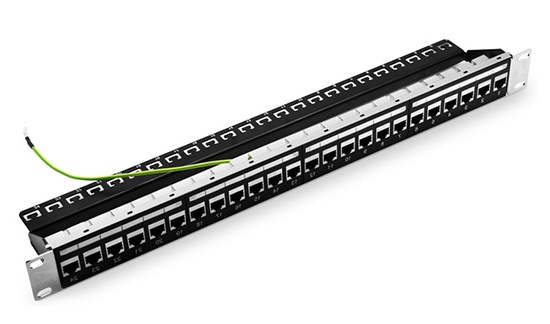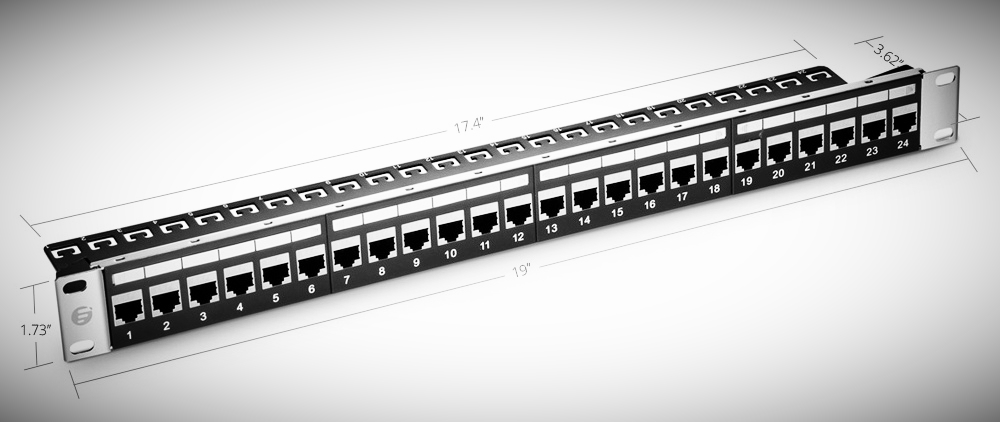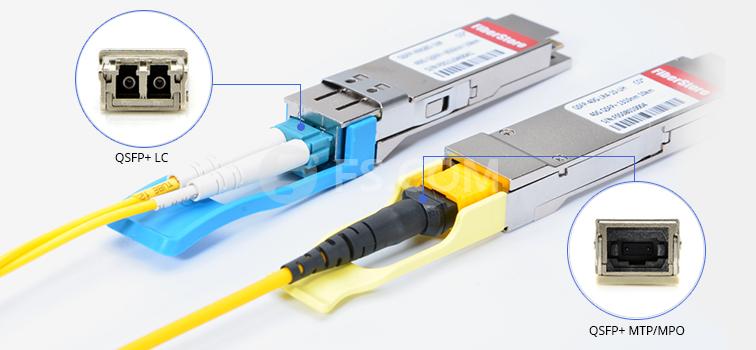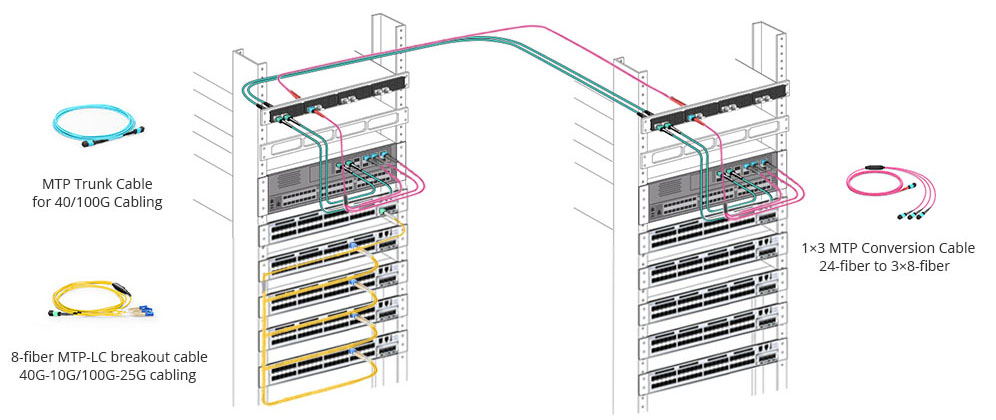What Is SFP Fiber Module?
Nowadays, almost all enterprise-class switches include two or more SFP (small form-factor pluggable) ports, allowing them to become part of a ring or star-based network topology spread among different buildings, floors or areas, and connected via fiber optic cabling. In many cases, SFP modules are also known as GBIC (mini-Gigabit interface converter) modules, as they have replaced the older GBIC transceivers. SFPs can be used and interchanged on a wide variety of products, and they can be either SFP fiber modules or SFP copper modules.
What Is SFP Fiber Module?
SFP fiber modules are connected by fiber optical cables, which are available with a variety of transmitter and receiver types, allowing users to select the appropriate transceiver for each link to provide the required optical reach over multimode fiber or single-mode fiber.

Optical SFP modules are commonly available in several different categories with different features:
- For multi-mode fiber, with black or beige extraction lever; for single-mode fiber, with blue extraction lever
- SX - 850 nm, for a maximum of 550 m at 1.25 Gb/s (Gigabit Ethernet) or 150m at 4.25 Gb/s (Fibre Channel)
- LX - 1310 nm, for distances up to 10 km
- BX - 1490 nm/1310 nm, Single Fiber Bi-Directional Gigabit SFP Transceivers, paired as BS-U and BS-D for Uplink and Downlink respectively, also for distances up to 10 km
- 1550 nm 40 km (XD), 80 km (ZX), 120 km (EX or EZX)
SFP Fiber Module Datasheet
With a wide application in optical network, many manufactures like Cisco and FS.COM provide a variety SFP modules. These models can be used on a wide variety of network equipment and intermixed in combinations of 1000BASE-T, 1000BASE-SX, 1000BASE-LX/LH, 1000BASE-EX, 1000BASE-ZX, or 1000BASE-BX10-D/U on a port-by-port basis. Part of the main products of Cisco SFP Fiber Modules are listed as below.
| Product | Wavelength (nm) | Fiber Type | Operating Distance (m) | Transmit Power Range (dBm) | Receive Power Range (dBm) |
| 1000BASE-SX | 850 | MMF | 220, 275, 500, 1000 | -3 to -9.5 | 0 to -17 |
| 1000BASE-LX/LH | 1310 | MMF, SMF | 550, 10000 | -3 to -9.5 | -3 to -20 |
| 1000BASE-EX | 1310 | SMF | 40000 | +3 to -1 | +1 to -22 |
| 1000BASE-ZX | 1550 | SMF | Around 70 km | +5 to 0 | -3 to -23 |
| 1000BASE-BX-U | 1310 | SMF | 10000 | 3 to -9 | -3 to -19.5 |
| 1000BASE-BX-D | 1490 | SMF | 10000 | 3 to -9 | -3 to -19.5 |
| GLC-BX40-D-I | 1550 | SMF | 40000 | -5 to +3 | -25 to +3 |
| GLC-BX80-D-I | 1490 | SMF | 80000 | -2 to +3 | -27 to +3 |
| GLC-GE-DR-LX | 1310 | SMF | 10000 | -9.5 to -3 | -25 to +3 |
SFP Fiber Module vs SFP Copper Module
SFP port can be plugged in with both SFP fiber module and SFP copper module. The biggest difference between SFP fiber module and SFP copper module lies in the cabling method. As it has been mentioned before, a SFP fiber module runs on a optical fiber (SMF/MMF). While a SFP copper module works on a twisted copper cable (CAT5/CAT5a/cat6). Except for the cabling specification, their transmission distances and connectors are also different.
| SFP Module Type | Cabling Method | Connector | Transmission Distance | Maximum transmission rate |
| SFP Fiber Module | optical fiber | RJ45 | 100m | 1000 Mbps / 1 Gbps |
| SFP Copper Module | twisted copper cable | Duplex LC | Over 100m | 1000 Mbps / 1 Gbps |
Summary
SFP module can connect various network devices such as switch, router, or fiber media converter to a fiber optic or copper networking cable. It is a popular industry format jointly developed and supported by many network component vendors. For SFP fiber module, it can transmit signal over a longer distance than SFP copper module. And the price for SFP fiber module is also cheaper than SFP copper module, so it gains more edges and popularity in the market of SFP modules.
The Difference Between Cat5e vs Cat6 Patch Panel
To build a flexible and tidy cabling system. Patch panels are something we can never forget. The panel enables speedy UTP interconnections to hubs, routers, and other active equipment. Ethernet patch panel on the market comes in various types, such as 24 port patch panel or 48 port patch panel for Cat5e or Cat6 that is shielded or unshielded. So what’s difference between Cat5e Patch Panel and Cat6 Patch Panel? Can I use cat5e rated patch panel with cat6 cabling?
Cat5e vs Cat6 Patch Panel: To Know About Cat5e Patch Panel
Cat 5e patch panels meet the standards of TIA/EIA 568 industry specifications, which can help enhance the network performance in a maximum and keep up with the growing changes in your network. For now, there are many Cat 5e patch panel products that customers can pull off the shelf. Cat5e Ethernet patch panels from reliable supplier like FS are made from steel materials so that they can stand up even the most extreme conditions. With numbers labeled on ports, it’s easy for cable organization. FS Cat5e patch panels are available in 6-port and 8-port module groupings, in 8, 12, 24, and 48-port sizes. The high density panel design can be mounted to standard racks or cabinets, accommodate top, bottom or side cable entry, and also save valuable rack space.
Cat5e vs Cat6 Patch Panel: To Know About Cat6 Patch Panel
As it’s name suggests, Cat6 patch panels is specially designed for Cat6 cabling in 1 Gigabit Ethernet applications. With the help of these patch panels, you can achieve easy management and save data center rack space. They can meet or exceed the TIA/EIA 568 industry specification. All these Ethernet patch panels feature both T-568A and T-568B wiring configurations. Each patch panel terminates with standard 110 termination tools on the rear, which allows quick installations. Panels in FS cover 12, 24, 48, and 96-port configurations. Patch panels can be configured with six or eight port modules.
Cat5e vs Cat6 Patch Panel: Can I Run Cat6e on a Cat5e Patch Panel?
Actually, there isn't much practical difference in the Ethernet patch panels themselves. But there is a difference in the wire gauge specified between cat5/5e and cat6, and Cat6 wire gauge is typically larger which can be an issue when punching down on a 5e block. That’s to say:
- When punching down Cat5/5e wire on a Cat6, the Cat5/5e wire is enough smaller that it is possible to get what looks like a good punch, but the insulation on the wire is not actually penetrated or is only partially penetrated by the vampire jaw of the punch block.
- When punching down Cat6 wire on a Cat5/5e panel, the larger wire can end up bending or even breaking the vampire jaws on the punchdown block.
In both cases, using care and testing each connection, you can usually make it work. If your just doing one panel at home you are probably OK. However it wouldn't be recommended if doing several panels or working on an enterprise/commercial jobs that you plan to warrant the work.
MTP vs MPO Connector for Dater Center’s High-density Demand
High density has been a hotly contested subject in the world of data centers for years. Today’s cyber world is moving ahead at an incredible speed, we’ve seen an unprecedented the demand for high-speed and high-density in data center. And 40Gb/s and 100Gb/s are more commonplace and now become a trend and hotspot for data-center cabling system. In such a circumstance, we can predict that MTP fiber connector and MPO fiber connector will eventually replace the standards for fiber optics as known.
MTP vs MPO Connector for High Density Needs
High density networking is based on two components. One, being able to have concentrated port density. Two, being able to have large numbers of fibre cores connecting nodes of the network. Most connectors (LC, SC, FC) have one fiber through them. The MTP/MPO connector has been designed as a “multi-fiber” connector. Going through the MTP connector wiki and MPO connector wiki, the MPO connector and subsequent standard were developed in the late 1980’s by the NTT-AT corporation. The MTP by US Conec corporation soon came after that with some additional features like a removable housing, elliptically shaped alignment pins, and the ability to change the connector’s gender. Current MPO connectors now offer these features. The main thing to remember is that the MTP connector adheres to the MPO standard. Therefore, MTP and MPO connectors are interchangeable.
The MTP connector is the same size as a traditional SC connector. However, the MTP connector has 12 fibers to the SC’s one fibre. This 12 fold increase in density enables a much greater port density at any point on the network. There are also 24 fibre and 48 fibre connectors within the MTP range that are also the same size as an SC connector.
MTP vs MPO for Multi-Fiber Solution
The MPO fiber connector and MTP fiber cable connector can offer up to 12 times the density of standard connectors, providing significant space and cost savings. Due to this fact and its excellent performance in various applications, many manufacturers now offer a wide range of MTP/MPO products, such as MTP / MPO Cable Assemblies, Fanout / Breakout Cables, MTP / MPO Trunk Cables, MTP / MPO Fiber Optic Plug-N-Play Cassettes, MTP / MPO Adapters, MTP / MPO Fiber Optic Loopbacks and etc.
With its higher port density, MTP/MPO fiber is easier to install - just pull 1 cable with 12, 24, or more fibers for one easy plug-in. Delivers big savings in installation time and cost. And High density MTP/MPO trunk cables can come with up to 288 fibers in a single cable.
Summary
MPO fiber connector and MTP fiber cable connector offer ideal solution to set up a high-density and high-performance data networks with the advantages of time saving and cost saving. Considering the huge benefits it they have brought and their special role in the migration to 40/100 Gigabit Ethernet, MTP/MPO connector will definitely gain more and more popularity among data centers.
Do You Really Need a White Box Switch?
Although white box switches have been emerged for years, many people still tend to consider switches first from branded companies first when buying a fiber optic switch. The adoption of white box switch has been limited to niche companies that have large engineering departments. Over the years, the market of fiber optic market has been dominated by select vendors like Cisco, HP, Arista and Juniper. However, white box switch is coming to break the ice.
White Box Switch: What’s It?
The phrase "white box" has long been used to apply to no-name computers. The same ODMs (original design manufacturers) that produced them are getting into the game of manufacturing white-box switches. White-box switches look just like any other switch, but they are not installed with operating systems (OS). Since every switch needs an operating system, white box switches are useless without software. The OS can be chosen by the customers based on their actual needs. This OS needs to seamlessly integrate with existing L2/L3 topologies and support a basic set of features. Beyond this, there should be new capabilities delivered as a result of "opening up" the network switch. Also many third party provide white box switches that are already operating systems like ICOS or Cumulus while they are rolling off the production line.

White Box Switch: What Makes It Superior over Traditional Switch
Despite the fact that the use of white box switches has been limited for a couple of reasons, such as customer worries for product quality and technical support, white box switches have come a long way from where they were. And I believe they are now ready for a broader market. I know some of you may doubt it and think it is not the one for you when buying a gigabit ethernet switch. But if you dig into it, you can see the white boxes have improved significantly in the following areas:
1. High flexibility, as their main function is to meet the data demands.
2. These are helpful to provide efficiency and productivity to the business.
3. Lower operating cost.
4. Lower capex Methods.
5. Less costs than equivalent speed switches.
6. White box switches are open networking switches.
7. The SDN controller is accountable for centralizing the network.
8. White box switching software can be easily attainable through any reseller or partner directly.
Summary
Maybe a white box gigabit switch is not the best gigabit switch in your heart right now, it is still undeniable that white box switch will be the future trend for data center siwtches. Many mainstream networks vendors also began to provide white box switches. Also, these will come shipped with tried-and-true network operating systems from vendors such as Pica8 and Cumulus.
Datasheet of 40G QSFP Module
When it comes to selecting 40G QSFP modules, customers may be dazzled by the various products provided by various suppliers. Some of them may directly purchase from big brands like Cisco. Actually, except for those well known brands, many other rising companies like FS also provide 40G QSFP transceivers, which usually come at a much lower price with with a high quality. This post will demonstrate the 40G QSFP Datasheet provided by FS.
40G QSFP Datasheet: QSFP 40G SR4 Datasheet
The S-Class FS 40GBASE-SR4 QSFP module supports link lengths of 100 and 150 meters, respectively, on laser-optimized OM3 and OM4 multimode fibers. QSFP 40G SR4 transceiver is aligned to IEEE 40GBASE-SR4 optical specifications which support high-bandwidth 40G optical links over 12-fiber parallel fiber terminated with MPO/MTP multifiber female connectors. Because IEEE 40GBASE-SR4 does not support 4x10G breakout connectivity to 10GBASE-SR, see QSFP-40G-SR4 or QSFP-40G-CSR4 for such applications. QSFP 40G SR4 does not support FCoE. More specific details of FS QSFP 40G SR4 Datasheet can be obtained in the table below.

40G QSFP Datasheet: QSFP 40G LR4 S Datasheet
The FS 40GBASE-LR4 QSFP module supports link lengths of up to 10 kilometer over a standard pair of G.652 SMF (single-mode fiber) with duplex LC connectors. The QSFP-40G-LR4-S module supports 40GBASE Ethernet rate only. The 40 Gigabit Ethernet signal is carried over four wavelengths. Multiplexing and demultiplexing of the four wavelengths are managed in the device. QSFP-40G-LR4-S does not support FCoE. More information have been shown in the following QSFP 40g LR4 S Datasheet.

QSFP+ SR4 vs QSFP+ LR4: Which One to Choose?
After going through QSFP 40G SR4 Datasheet and QSFP 40g LR4 S Datasheet, you may have had a basic understanding of QSFP 40G SR4 and QSFP 40g LR4. SR is short for short reach and LR represents Long Reach. The most obvious difference is that 40GBASE-SR4 is with MPO/MTP port while the 40GBASE-LR4 is with the Duplex LC port. The cost of 40GBASE-SR4 QSFP+ is more cheaper than the 40GBASE-LR4 QSFP+. Additionally, the fiber cost of the cabling with them also have a big difference. Because SMF cabling is more expensive than the MMF cabling.
Summary
As speeds have increased to 40G, the quad small form-factor pluggable (QSFP) has become the high-density transceiver of choice. Hoping this post on FS 40G QSFP Datasheet may help you when selecting 40G optical transceivers.
Fiber Optic Connector Selection Guide
For the past few decades since 1980s, many different types of fiber optic connectors such as MTP connector and MPO connector, have been provided by various manufacturers. Despite the fact that these types of optical connector varies greatly in mechanical design, the most basic components a fiber connector are more or less the same. They both have a fiber ferrule, connector sub-assembly body, connector housing, and stress relief boot, etc. Next, part of the most commonly seen connectors will be introduced to you one by one.
LC connector
It works in both simplex and duplex with 1.25mm ferrule. Available in single mode and multimode. Externally LC connectors resemble a standard RJ45 telephone jack. Internally they resemble a miniature version of the SC connector. LC connectors use a 1.25mm ceramic (zirconia) ferrule instead of the 2.5mm ferrule. LC connectors are licensed by Lucent and incorporate a push-and-latch design providing pull-proof stability in system rack mounts. Highly favored for single mode applications.
MTP connector and MPO connector
MTP connector and MPO connector are compatible ribbon fiber connectors based on MT ferrule which allow quick and reliable connections for up to 12 fibers. They are intended for installations that require many fiber connections. Up to 12 fibers in a ribbon are stripped to 125um cladding and inserted into 250um spaced parallel grooves. The ferrule also includes two 0.7mm diameter holes, running parallel to the fibers on the outer side of the ferrule. These two holes hold precision metal guide pins which align the fibers with tight tolerances.
MTP connector and MPO connector feature male and female connector design. Male connectors have two guide pins and female connectors do not. Both connector types need an adapter to mate a pair of male and female connectors. Because MTP connector and MPO connectors are trying to align so many fibers at once, their coupling loss are typically bigger than single fiber connectors.
ST Connector
ST connector comes in simplex with a twist-on mechanism, and it is available in both single mode and multimode. It is the most popular connector for multimode fiber optic LAN applications . It has a long 2.5mm diameter ferrule made of ceramic (zirconia), stainless alloy or plastic. Unlike MTP connector and MPO connector it mates with a interconnection adapter and is latched into place by twisting to engage a spring-loaded bayonet socket.
Summary
Whether you are installing a brand new fiber optic network or repairing a legacy system using , hope this fiber optic connector selection guide will help you determine what kind of connector you are looking at or what type of connector you need to replace.
MTP vs MPO Connector:Which One to Choose for Your Fiber Cable?
When we talk about multi-fiber connector, MTP connector and MPO connector are two words that are inevitably to be mentioned. For many people, they are just the same thing. However, the fact is that MTP connector and MPO connector differ from each other just as MTP fiber cable and MPO fiber cable, which in the data centers play an important role in ultra-high density cabling.
Details of MTP connector and MPO connector
The MPO connector (short for multi-fibre push on) is a multi-fibre connector with a specific interface type, while the MTP connector is a more superior type of MTP connector with improved mechanical and optical performance capabilities. There are several reasons why MTP connectors are superior to generic MPO connectors.

1. The MTP connector housing is removable, which allows for easy transition from male to female and vice-versa.
2. The MTP connector offers ferrule float for maximised mechanical performance and reduced strain during side load.
3. The MTP connector uses stainless steel guide pin tips, which are elliptical shaped to improve guidance and reduce guide hole wear.
4. The MTP connector has a metal pin clamp which centres the push spring, and therefore eliminates lost pins and potential fibre damage from the spring.
Details of MTP fiber cable and MPO fiber cable
The number of network connections in data centers is rising rapidly. Traditional fiber cables can make the data center crammed and difficult to manage. To solve this problem, data centers have to achieve ultra-high density in cabling to accommodate all of the cabling required. The MTP fiber cable and MPO fiber cable, which bring together 8, 12 or 24 fibers in a single interface have been proven to be a practical solution. Incorporating to meet the 40GBASE-SR4 and 100GBASE-SR10 standard, The MTP/MPO multi-fiber connector of MTP cable and MPO cable is about the same size as a SC connector but can accommodate 8, 12 or 24 fibers, thus offering savings in circuit card and rack space. MTP fiber cable and MPO fiber cable are composed of MTP/MPO connectors and fiber optic cables, other connectors such as LC may also be found in some kinds of MPO/MTP fiber cables. The fiber cables used are generally OM3 and OM4, which are laser optimized multi-mode optical fibers.

Summary
Choosing the right kind of connector is an important step in building a data infrastructure that will last. MTP and MPO are two types of common connectors that are widely used, and MTP fiber cable and MPO fiber cable are two central components of a 40G parallel optical link. This connection decides whether the insertion loss exceeds the attenuation budget and whether the return loss is high enough. In the end, the desired bandwidth can only be reached if all components in a parallel optical link satisfy the highest requirements.






